UPDATE Dec 21, 2006: Winners announced
GRAND PRIZE: Robotic building cleaning system (Fuji Heavy Industries and Sumitomo). The system received high marks for its efficiency and its ability to work both independently and alongside humans. The judges believe the robot has great potential to develop the market for robotic cleaning systems, as well as establish new business models in which robots and humans work side by side to provide inexpensive cleaning services.
SMALL-TO MEDIUM-SIZED VENTURE PRIZE: KHR-2HV (Kondo). The judges gave high marks to KHR-2HV for its relatively low price tag and its popularity with individual users both young and old. KHR-2HV was also recognized for fostering closer ties between humans and robots, as well as for its educational value.
HONORABLE MENTION: My Spoon (SECOM). The judges awarded their special prize to My Spoon for its contributions to society. The robot has received praise both in Japan and overseas for helping people enjoy the meals they want to eat and enabling them to eat with friends and family. The judges recognized the high quality of My Spoon resulting from SECOM's close cooperation with users and medical professionals in the development phase. They also like it because it is affordable.
// Dec 21, 2006 //
====================
Japan's Ministry of Economy, Trade and Industry (METI) has announced its top ten list of finalists for the 2006 Robot Award. The ten robots selected from 152 applications fall into four categories -- service robots, industrial robots, public sector robots, and small- to medium-sized venture robots.
METI established the annual Robot Award this year to recognize outstanding developments in the field of robotics, encourage further research and development, and stimulate demand. Winners of the grand prize and the special prize for small- to medium-sized ventures will be announced on December 21.
Here's a rundown of the top robots in each category...
SERVICE ROBOTS:

- Paro -- seal robot with therapeutic properties (Intelligent System/ AIST/ Microgenics)
Paro is a furry white robot modeled after a baby harp seal. Paro can serve as a pet alternative for general households, and research has shown that Paro has therapeutic effects on patients. Paro's entire body is covered in tactile sensors, and its actuators provide it with smooth movement. Lovingly crafted one by one, Paro is recognized for its safety, cleanliness, user-friendliness and durability. About 800 of the robotic seals have been adopted around Japan, and Paro's future plans include overseas travel. [More]
* * * * *
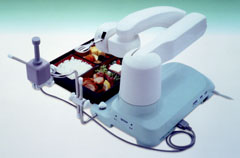 - My Spoon -- meal assistance robot (SECOM)
- My Spoon -- meal assistance robot (SECOM)
Designed to assist patients unable to use their hands, My Spoon enables users to enjoy ordinary meals by transporting food from a tray to the patient's mouth, one bite at a time. Users can select from three levels of contol -- manual (joystick control), semi-automatic or fully automatic -- to best suit their physical condition. My Spoon is available outside Japan, in the Netherlands and other locations in Europe. [More]
* * * * *
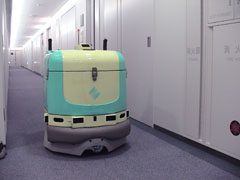 - Robotic building cleaning system (Fuji Heavy Industries/ Sumitomo)
- Robotic building cleaning system (Fuji Heavy Industries/ Sumitomo)
This autonomous robot roams the hallways of buildings, performing cleaning operations along the way. Capable of controlling elevators, the robot can move from floor to floor unsupervised, and it returns to its start location once it has finished cleaning. The robot is currently employed as a janitor at 10 high-rise buildings in Japan, including Harumi Triton Square and Roppongi Hills. [More]
* * * * *
INDUSTRIAL ROBOTS:
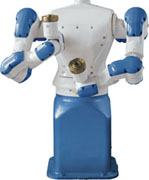
- MOTOMAN-DIA10/ MOTOMAN-IA20 (Yaskawa Electric)
These industrial robot arms are capable of human-like movement, which is great news for factories worried about Japan's shrinking population (and human labor force). The DIA10 consists of two 7-axis arms mounted on a torso.
According to this spec sheet (PDF), the robot has the "finesse of the human arm without the physical limitations." The same 7-axis design is incorporated into the IA20, a "snake" robot with great freedom of movement and the ability to operate in tight spaces.
* * * * *
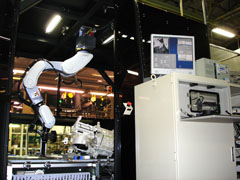 - High-speed reliability verification robot (Denso Wave)
- High-speed reliability verification robot (Denso Wave)
This robot relies on advanced machine vision technology to perform automated inspections on the go.
Highly reliable inspections can be performed at each location without stopping the line, allowing for speedier and more cost-effective operations.
[More]
* * * * *
PUBLIC SECTOR ROBOTS:
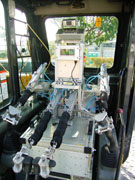
- Tele-operated construction equipment (Fujita/ Technical Office of Kyushu, Ministry of Land, Infrastructure and Transport (Kyugi))
These remote-control unmanned construction machines were originally developed for dangerous recovery operations following disasters such as avalanches and rockslides.
Designed to prevent the occurrence of secondary disasters and greatly limit further damage and injury, these robots were deployed at the site of a disastrous mudslide that occurred in Okinawa in June 2006. [More]
* * * * *
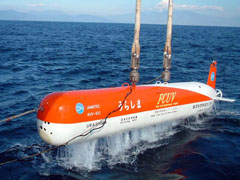 - Urashima -- deep-sea autonomous underwater vehicle (Japan Agency for Marine-Earth Science and Technology)
- Urashima -- deep-sea autonomous underwater vehicle (Japan Agency for Marine-Earth Science and Technology)
Urashima is a remotely operated vehicle for deep-sea exploration. The 10-meter long vessel relies on hydrogen-based fuel cell batteries that allow it to travel much greater distances than vessels powered by standard lithium-ion batteries. Urashima is expected to play an important role in pre-dive surveys for manned submarines and in the survey of areas considered dangerous for or inaccessible by manned research submarines. [More]
* * * * *
SMALL-TO MEDIUM-SIZED VENTURE ROBOTS:
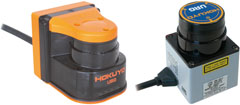
- URG Series scanning laser range finders (Hokuyo)
These lightweight, compact laser range finders feature low power consumption, making them ideal sensors for autonomous mobile robots. [More]
* * * * *
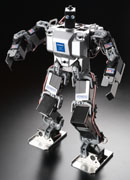 -KHR-2HV (Kondo)
-KHR-2HV (Kondo)
KHR-2HV is a high-performance build-it-yourself biped humanoid robot kit.
The popular KHR-2HV is faster, lighter and more agile than its predecessor, KHR-1, and it is packed with more controls, gears, servos and software.
Seventeen adjustable joints allow KHR-2HV to perform back flips, cartwheels and human-like moves, and USB connectivity means you can teach it lots of neat tricks. [More]
* * * * *
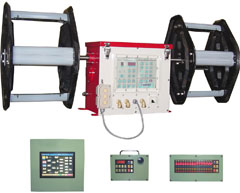 - Squid-fishing machine (Towa Denki)
- Squid-fishing machine (Towa Denki)
Towa Denki has made a number of improvements to its automated squid-fishing machines since the company began manufacturing them in the 1970s.
Relying on functions such as high-tech load detectors, squid finders and water depth detectors, the machines can perform automated operations that boost squid-fishing productivity. [More]
[Source: Robot Award 2006]
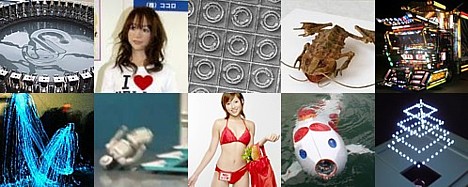

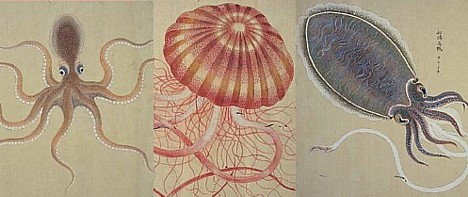


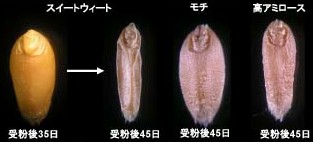 On December 12, researchers from Japan's National Agriculture and Food Research Organization (
On December 12, researchers from Japan's National Agriculture and Food Research Organization (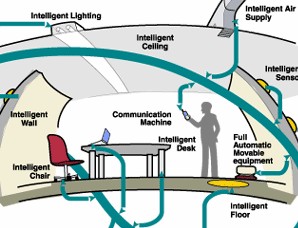

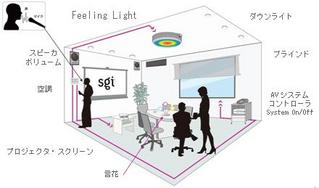
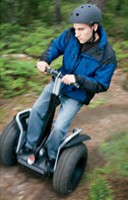 SGI, which recently became Segway's official distributor in Japan, is also developing a function that enables RoomRender to control the two-wheeled transportation devices. In the future, RoomRender will be able to send a Segway to an occupant that asks for it, and it will return a Segway to its battery charger when the power starts running low.
SGI, which recently became Segway's official distributor in Japan, is also developing a function that enables RoomRender to control the two-wheeled transportation devices. In the future, RoomRender will be able to send a Segway to an occupant that asks for it, and it will return a Segway to its battery charger when the power starts running low.  - Paro -- seal robot with therapeutic properties (Intelligent System/ AIST/ Microgenics)
- Paro -- seal robot with therapeutic properties (Intelligent System/ AIST/ Microgenics)
 - My Spoon -- meal assistance robot (SECOM)
- My Spoon -- meal assistance robot (SECOM) - Robotic building cleaning system (Fuji Heavy Industries/ Sumitomo)
- Robotic building cleaning system (Fuji Heavy Industries/ Sumitomo) - MOTOMAN-DIA10/ MOTOMAN-IA20 (Yaskawa Electric)
- MOTOMAN-DIA10/ MOTOMAN-IA20 (Yaskawa Electric)
 - High-speed reliability verification robot (Denso Wave)
- High-speed reliability verification robot (Denso Wave) - Tele-operated construction equipment (Fujita/ Technical Office of Kyushu, Ministry of Land, Infrastructure and Transport (Kyugi))
- Tele-operated construction equipment (Fujita/ Technical Office of Kyushu, Ministry of Land, Infrastructure and Transport (Kyugi))
 - Urashima -- deep-sea autonomous underwater vehicle (Japan Agency for Marine-Earth Science and Technology)
- Urashima -- deep-sea autonomous underwater vehicle (Japan Agency for Marine-Earth Science and Technology)
 -KHR-2HV (Kondo)
-KHR-2HV (Kondo) - Squid-fishing machine (Towa Denki)
- Squid-fishing machine (Towa Denki)